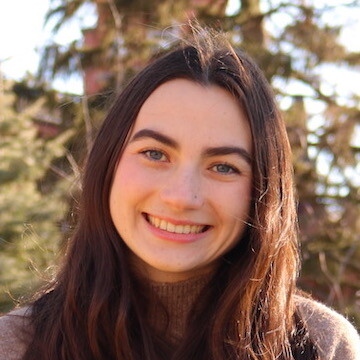Mobile Menu
- About Us
- Partnerships
- Events
- News
- Research
- Education
- Infrastructure
- Community

The next instalment of the T-CAIREM Trainee Rounds, taking place on June 1, features public presentations by two emerging U of T researchers including Anglin Dent. Dent is currently pursuing her MSc in Laboratory Medicine and Pathobiology.
At the June Trainee Rounds, she'll be presenting on how clinicians can use digital pathology tools to explore cancerous tumors. During her presentation, she'll explain the development of her team's unsupervised AI tool that is capable of identifying important differences within and across cancer tumors.
Here's a short Q&A to learn more about Dent and her exciting research.
What inspired you to research this topic?
I have been examining the application and integration of Artificial Intelligence in the pathology workflow with the Diamandis lab since I was an undergraduate volunteer. Early on in my exposure to the field, it was clear that there are many barriers limiting the widespread clinical adoption of AI-based digital pathology. With these limitations in mind, the Diamandis AI team focused on developing digital pathology tools that aim to support and increase efficiency within the established pathology workflow rather than replace the human clinician. The exposure that I gained to this innovative research as an undergraduate student inspired me to return as a graduate student so that I could continue to study the optimal method to integrate AI tools into pathology.
What outcomes do you hope your research will eventually lead to?
Our team has shown that our unsupervised workflow is capable of identifying clinically relevant intra- and inter-tumoral differences across a variety of tumor subclassifications. We're now examining how we may realistically integrate this tool into the current pathology workflow and resolve current diagnostic and prognostic challenges. We are also examining if our tool could be used to automate the detection of biologically distinct tumor sub-regions for molecular characterization and therapeutic targeting. If successful, our tool could assist in the routine characterization of such regions and help propose personalized drug combinations that target a larger fraction of a tumor’s true biology.
What are your professional goals after you complete your degree?
After completing my master’s degree, my dream would be to start training to become a clinician-scientist. I would be thrilled to continue studying how we may optimally integrate novel technologies into the healthcare field, while experiencing first-hand their impact in a clinical setting.
What do you like to do when you aren’t working?
When not in the lab, I like to spend my free time baking, getting outside, and watching playoff hockey!
What advice would you give to high school students who are interested in following in your footsteps?
My main piece of advice would be to get out of your comfort zone and explore different areas of research with an open mind. Given that science and research is always evolving, you can never predict what areas will come to the forefront and attract your attention. I think it’s crucial to be open to opportunities as they arise.
What’s the best part of doing the type of research that you do?
One of the most interesting and exciting aspects of studying the intersection of AI and healthcare is the opportunity for collaboration among various disciplines. By combining the expertise of health professionals, computer scientists, and research trainees, we can utilize our diverse backgrounds to generate innovative solutions and optimize both the technological development and clinical implementation of our AI tools.
